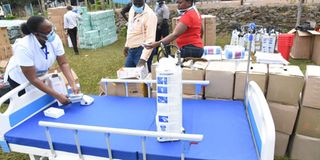Pandemic a huge opportunity to get better

What you need to know:
- We need well-equipped facilities with highly trained motivated specialists to achieve universal health coverage.
- The setback for many a health facility — reduction in the number of people seeking treatment — has turned into a major opportunity to employ technology.
- The pandemic has also proved that the public and private sectors working for a common goal can easily overcome any challenge.
The Covid-19 pandemic may have ravaged the world but it has also brought along a positive tide. In the healthcare sector, for instance, it has catalysed investments in human and infrastructure development.
A World Bank report released in May showed some countries responded to the public health crisis by setting up emergency health projects — such as improving surveillance systems, training front-line responders, expanding testing and providing medical equipment.
Other frontiers to experience a boost include building or expanding healthcare facilities at the national and county levels, creating systems for real-time community-based tracing and strengthening coordination and collaboration.
RESPONSE BEDROCK
Strong health systems are the bedrock of a robust response to the pandemic. The situation report noted that they allow countries to monitor the utilisation of health services.
Our challenge is having not faced a pandemic of this magnitude before, unlike West and Central African countries, which had Ebola experience. Closure of major supply routes and destinations meant we had to reflect on our sources of medical supplies and quality of health facilities and workers.
A peculiar thing with Covid-19 is that it can affect any country, pushing the demand for medical equipment so that even those that produce surplus for export face shortages.
Local institutions assembled the much-needed ventilators, PPE, face masks and sanitisers in record time. Innovations became part of our solution to the pandemic. Locally made face masks are abundant; soon, we could be exporting them.
Although earlier projections had indicated huge infection rates, quick intervention by public and private sector players have been very helpful.
For instance, hardly a week passes before Kenyatta National Hospital receives donations to aid the fight against Covid-19.
BEST MIX
County hospitals have also witnessed a tremendous increase in the number of intensive care unit (ICU) beds and increased supply of ventilators and oxygen. KNH now has 80 ICU beds, from 30.
As part of their preparedness, health facilities have conducted training for health workers and set up isolation pods. That means having the best mix of doctors and nurses capable of handling any pandemic.
The pandemic has also proved that the public and private sectors working for a common goal can easily overcome any challenge.
The Centre for Public Health and Development, for instance, and other health stakeholders are facilitating the availability of subsidised oxygen through Hewa Tele.
The media has been instrumental in public health education, which has, in turn, made the public more aware of what to look out for should they suspect themselves or neighbours as having the virus.
The setback for many a health facility — reduction in the number of people seeking treatment — has turned into a major opportunity to employ technology. Health Cabinet Secretary Mutai Kagwe’s launch of a telemedicine facility at KNH is such a milestone.
A key Covid-19 lesson is that investment in healthcare can no longer take the back seat in our budget. We need well-equipped facilities with highly trained motivated specialists to achieve universal health coverage.
Dr Kamuri is the CEO of Kenyatta National Hospital. [email protected] @CeoKnh





